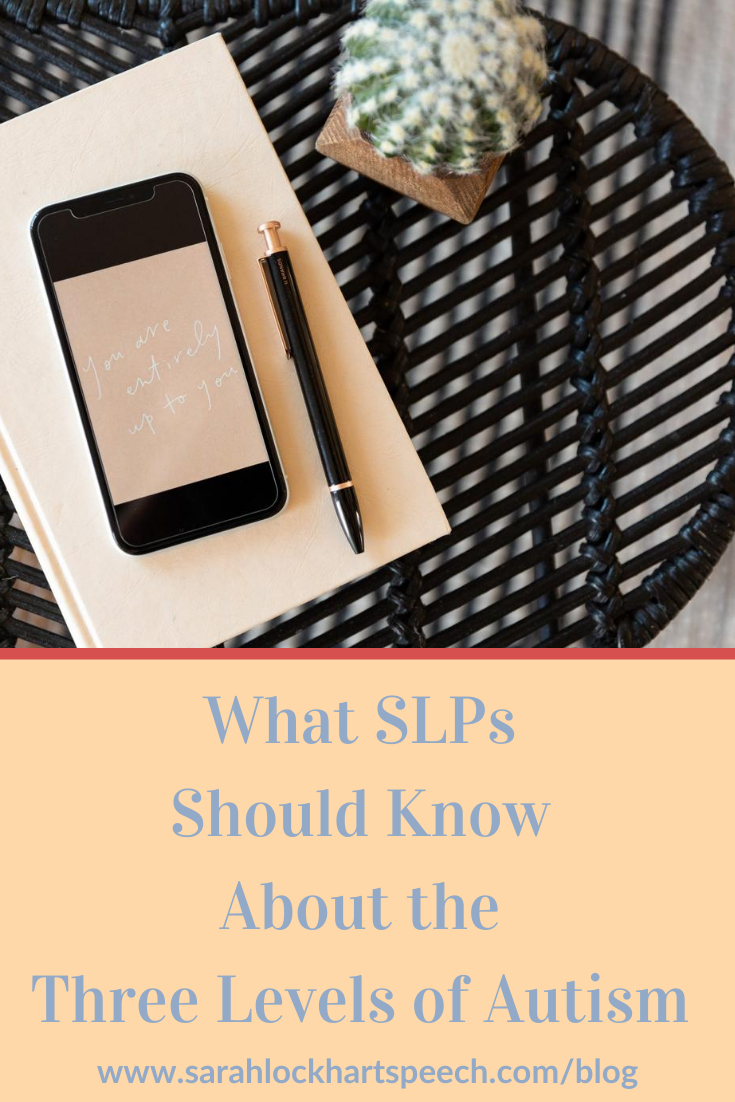Lately I’ve been hearing more and more about the three levels (1-3) of Autism.
Full disclosure, I hadn’t heard about these levels before this year, even though this leveled system has existed since 2013 when the DSM-5 was published. The DSM is the Diagnostic and Statistical Manual (5th Edition), which is primarily used by mental health professionals. Previous to this year, I hadn’t heard many parents or medical professionals use this terminology; but especially lately I’ve had Autism Reports by medical professionals as well as parents use this terminology. I had to dig in, research, and figure out what these levels meant, and what it means to SLPs. In this post, you’ll learn the basics about the 3 Levels of Autism as defined in the DSM so that you can be familiar with these levels, in case they are used by parents or related professionals. As SLPs, we don’t use the DSM as a diagnostic tool, but it’s helpful to be familiar with the terminology that we will see moving forward. So, let’s get to it!
The Basics
The levels of Autism Spectrum Disorder in the DSM-5 go from 1-3, from the least to the most impacted. For example, a child with Level 1 Autism may appear as neurotypical in many social situations (to untrained professionals), whereas as a child with Level 3 Autism will “require very substantial support” and will typically have just a few words and you may see a lot of repetitive and restrictive behavior.
It’s important to know that the levels are a way to describe children diagnosed with Autism, and the overall criterion for diagnosis remains the same. SLPs are typically very familiar with these: challenges with social communication and interaction, restricted and repetitive behaviors, symptoms must be present in early life, must result in a clinically significant level impact on functioning, and other impairments (such as Intellectual Disability or Developmental Delay) have been ruled out as the primary challenge.
Level 1
Autistic individuals at this level have challenges with inflexibility which have significant effects, difficulty transitioning between activities, and problems with organization and planning.
This level is described as “requiring support” meaning that without support in place, these challenges would be noticeable by others. This individual may have strong language skills, but difficulty taking turns in conversation and initiating conversation.
Level 2
Autistic individuals at this level have social challenges which are apparent even with supports in place.
This level is described as “requiring substantial support,” and that the effects are noticed by the casual observer. This individual may speak in phrases and has some challenges in language skills, and limited initiations and responses in conversation would not be similar to those of neurotypical peers.
At Level 2, you would typically see behavior challenges, inflexibility, significant difficulty with change, and restrictive and/or repetitive behaviors that are noticeable to the casual observer and “interfere with functioning in a variety of contexts.” Transitions or changes result in distress in individuals with Level 2 ASD.
Level 3
Autistic individuals at this level “require very substantial support” for communication and social scenarios. This level is characterized by severe challenges in social interaction, communication, and a minimal response to the social/communication initiation of others. Autistic individuals at this level may have just a few verbal words, and it can be a significant challenge to figure out what they’d like or need. When others initiate, an individual at Level 3 would have a limited response or no response.
At Level 3, you would typically see restricted and/or repetitive behaviors that significantly impact their daily functioning and great distress shifting attention and transitioning.
Test Your Knowledge
Take a look at these three Kindergarten students and decide for yourself if each student’s profile most closely aligns with Level 1, 2, or 3; the answer key is in the next section.
Taylor is a Kindergarten student who was diagnosed at age 4 and has attended speech therapy since that time. During transitions Taylor continues to complete the previous activity, and it is especially difficult to get her to move on to a new activity if she doesn’t feel like the activity is complete, or if it’s a highly preferred activity. Taylor wanders the classroom, and her teacher has decided that this is a self advocated for break, and gets a few minutes to do this when she opts to by using a break card. Taylor speaks in words and short phrases and can be difficult to understand, since she has difficulty taking turns in conversation and staying on topic.
Blake is starting Kindergarten and was identified as an Autistic individual at age 3. Since then, he received occupational therapy and speech therapy. Although Blake needs reminders, he can often self calm when asked “what would make you feel calm right now?” as he has been taught many strategies and has a few favorites. Blake is very verbal, but can get stuck on certain topics and benefits from reminders from social peers “let’s talk about something else,” and is flexible when this happens. Blake transitions between activities, but does well transitioning between activities in Kindergarten once he knows the schedule.
Meegan is a Kindergarten student who loves to play with Play Doh and enjoys listening to songs on YouTube. Her words are typically marked by echolalia (“that’s a tractor,”) and it’s difficult to figure out what she needs. She typically wanders the room, flapping her hands and blowing raspberries or lining up toys and looking at them from a side angle. Meegan uses an AAC device to communicate that she’s just starting to learn to use. During transitions, she typically yells or cries out, even if the transition is for a preferred activity.
Answer Key
How were those examples?
The answers are: 2, 1, 3.
These weren’t based on any particular students, but it can be affirming to realize that once you understand the levels, it becomes easier to figure out where your students would be, based on these levels.
As an SLP, I don’t diagnose children with levels of Autism or use these levels in my own therapy, but it has been useful to understand this framework as other professionals and parents use it to help me understand what they are talking about. Although we may or may not use these levels in our own therapy, communication or session notes, since others we communicate with will use these levels, it’s important to have a basic understanding of what they mean.
Could these levels be limiting? Yes. They provide a common framework, but if taken too seriously or as if they are permanent, they can downplay the rate of growth that many people have and can be taken too literally and prescriptively. These levels also are really based on a deficit framework, instead of a strengths-based framework, and I believe this is a change we will see in the future of ASD diagnosis and treatment. Until then, understanding this common language can be incredibly helpful to SLPs as we move forward to collaborate with other professionals.
Sarah Lockhart is a speech language pathologist in private practice in Ashland Oregon. She specializes in working with the birth to five population, particularly Childhood Apraxia of Speech and Autism.


